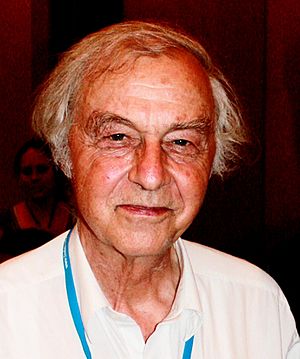Robert Huber facts for kids
Quick facts for kids
Robert Huber
|
|
|---|---|

Robert Huber in 2010
|
|
| Born | 20 February 1937 |
| Nationality | German |
| Citizenship | Germany |
| Alma mater | Technical University Munich |
| Known for | Cyanobacteria Crystallography |
| Awards |
|
| Scientific career | |
| Fields | Biochemist |
| Doctoral students | Nediljko Budisa |
| Other notable students | Peter Colman (postdoc) |
Robert Huber, born on February 20, 1937, is a German biochemist and a Nobel laureate. He is famous for his important work on photosynthesis. He figured out the structure of a special protein inside cell membranes using a method called X-ray crystallography. This helped us understand how plants and bacteria turn sunlight into energy.
Contents
Early Life and Education
Robert Huber was born in Munich, Germany, on February 20, 1937. His father, Sebastian, worked as a bank cashier.
He went to the Humanistisches Karls-Gymnasium school from 1947 to 1956. After that, he studied chemistry at the Technical University of Munich. He earned his diploma in 1960. He continued his studies there, focusing on how to use crystallography to understand the structure of different chemical compounds.
A Career in Science
In 1971, Robert Huber became a director at the Max Planck Institute for Biochemistry. There, his team worked on new ways to use crystallography to study proteins. Proteins are complex molecules essential for life.
Winning the Nobel Prize
In 1988, Robert Huber received the Nobel Prize in Chemistry. He shared this big award with two other scientists, Johann Deisenhofer and Hartmut Michel.
They won the prize for their amazing discovery about photosynthesis. Photosynthesis is the process plants and some bacteria use to make food from sunlight. The scientists were the first to get a clear picture of a special protein found inside the membranes of purple bacteria. This protein is key to how photosynthesis works.
They used X-ray crystallography to see the protein's exact structure. This was a huge step because it gave scientists the first detailed look at how photosynthesis happens at a tiny, molecular level. This discovery also helped us understand how photosynthesis works in other organisms, like cyanobacteria and even in the chloroplasts of higher plants.
Later Work and Research
In 2006, Huber started working part-time at Cardiff University. His role was to help develop the study of structural biology there.
Since 2005, he has also been doing research at the Center for Medical Biotechnology at the University of Duisburg-Essen. He was also one of the first editors for the Encyclopedia of Analytical Chemistry.
Awards and Honors
Robert Huber has received many important awards for his scientific work.
- In 1977, he was given the Otto Warburg Medal.
- In 1988, he received the Nobel Prize in Chemistry.
- In 1992, he was awarded the Sir Hans Krebs Medal.
- He became a member of the Pour le Mérite for Sciences and Arts in 1993.
- In 1999, he was made a Foreign Member of the Royal Society (ForMemRS).
His work has greatly helped us understand how proteins are built and how they work. For example, he studied the structure of trypsin inhibitor, which helped explain how enzymes work. He also looked at proteins involved in the electron-transfer systems and how they help move energy around in cells. His detailed studies have given us important insights into how molecules move and change within proteins.
Robert Huber has published around 400 scientific papers about his research.
Personal Life
Robert Huber is married and has four children.
See also
 In Spanish: Robert Huber para niños
In Spanish: Robert Huber para niños

